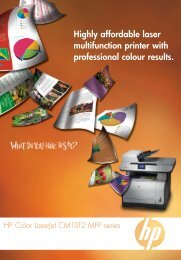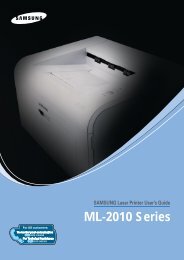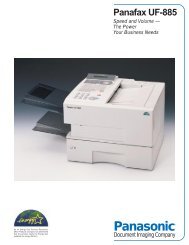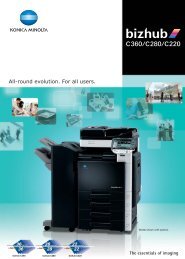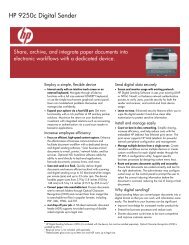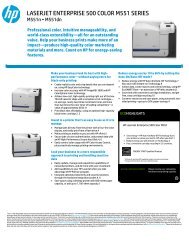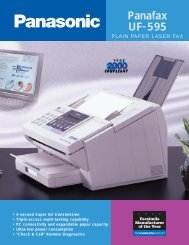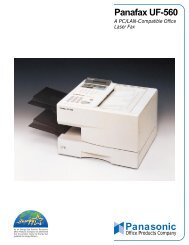Click to Download User Manual. - Home
Click to Download User Manual. - Home
Click to Download User Manual. - Home
- No tags were found...
Create successful ePaper yourself
Turn your PDF publications into a flip-book with our unique Google optimized e-Paper software.
Media sizes supported in each modeGuidelines for special print mediaCopy modeSingle sideprintingMode Size SourceDuplex printing aFax mode bLetter, A4, Legal, Folio,Oficio, Executive, ISOB5, A5All sizes supported bythe machineLetter, A4, Legal, Folio,Oficio, JIS B5, ISO B5,Executive, A5,Statementa. 75 <strong>to</strong> 90 g/m 2 (20 ~ 24 lb) onlyb. Only the optional fax kit is installed.• tray 1• optional tray• multi-purpose tray• tray 1• optional tray• multi-purpose tray• tray 1• optional tray• multi-purpose trayLetter, A4, Legal • tray 1• optional trayGuidelines for selecting and s<strong>to</strong>ring print mediaWhen selecting or loading paper, envelopes, or other print materials,keep these guidelines in mind:• Always use print media that conform with the specifications listed onpage 4.3.• Attempting <strong>to</strong> print on damp, curled, wrinkled, or <strong>to</strong>rn paper can causepaper jams and poor print quality.• For the best print quality, use only high quality copier grade paperspecifically recommended for use in laser printers.• Avoid using the following media types:- Paper with embossed lettering, perforations, or a texture that is <strong>to</strong>osmooth or <strong>to</strong>o rough- Erasable bond paper- Multi-paged paper- Synthetic paper and thermally reactive paper- Carbonless paper and Tracing paper.Use of these types of paper could result in paper jams, chemicalsmells, and damage <strong>to</strong> your machine.• S<strong>to</strong>re print media in its ream wrapper until you are ready <strong>to</strong> use it.Place car<strong>to</strong>ns on pallets or shelves, not on the floor. Do not placeheavy objects on <strong>to</strong>p of the paper, whether it is packaged orunpackaged. Keep it away from moisture or other conditions that cancause it <strong>to</strong> wrinkle or curl.• S<strong>to</strong>re unused print media at temperatures between 15 °C and 30 °C.The relative humidity should be between 10% and 70%.• S<strong>to</strong>re unused print media in a moisture-proof wrap, such as a plasticcontainer or bag, <strong>to</strong> prevent dust and moisture from contaminatingyour paper.• Load special media types one sheet at a time through the multipurposetray <strong>to</strong> avoid paper jams.• To prevent print media, such as transparencies and label sheets, fromsticking <strong>to</strong>gether, remove them as they print out.Media typeEnvelopesGuidelines• Successful printing on envelopes depends uponthe quality of the envelopes. When selectingenvelopes, consider the following fac<strong>to</strong>rs:- Weight: The weight of the envelope papershould not exceed 90 g/m 2 or jamming mayoccur.- Construction: Prior <strong>to</strong> printing, envelopesshould lie flat with less than 6 mm curl, andshould not contain air.- Condition: Envelopes should not be wrinkled,nicked, or otherwise damaged.- Temperature: You should use envelopes thatare compatible with the heat and pressure ofthe machine during operation.• Use only well-constructed envelopes with sharpand well creased folds.• Do not use stamped envelopes.• Do not use envelopes with clasps, snaps,windows, coated lining, self-adhesive seals, orother synthetic materials.• Do not use damaged or poorly made envelopes.• Be sure the seam at both ends of the envelopeextends all the way <strong>to</strong> the corner of theenvelope.AcceptableUnacceptable• Envelopes with a peel-off adhesive strip or withmore than one flap that folds over <strong>to</strong> seal mustuse adhesives compatible with the machine’sfusing temperature of 180 °C for 0.1 second.The extra flaps and strips might cause wrinkling,creasing, or jams, and may even damage thefuser.• For the best print quality, position margins nocloser than 15 mm from the edges of theenvelope.• Avoid printing over the area where theenvelope’s seams meet.4.4



